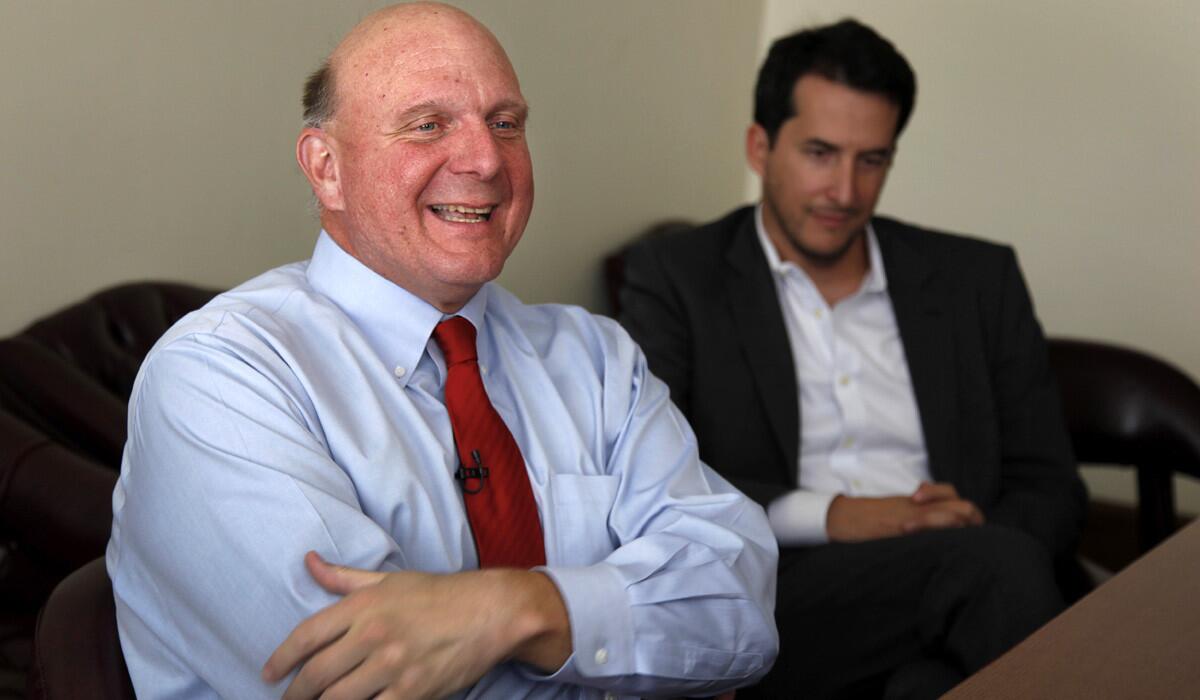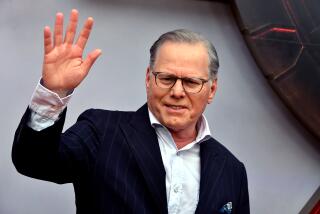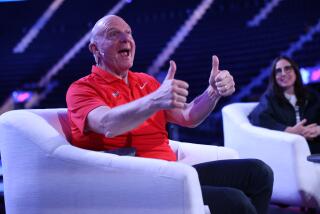Steve Ballmer ‘personable,’ ‘intense,’ but legacy at Microsoft mixed

That Steve Ballmer is buying a sports franchise is no surprise to anyone who worked with him over the many decades he was at Microsoft.
As a boy, born and raised in Detroit, he badly wanted to play basketball, but ended up a manager for his high school team. As an adult, what little time he spent away from the office included playing basketball with his kids. And his mornings often started with a pickup basketball game at a sports club next to the Microsoft campus in Redmond, Wash.
A few years ago he was part of a group that tried to keep the Seattle SuperSonics from leaving town. And more recently, he joined a group that tried to buy the Sacramento Kings. During those efforts, Ballmer was still chief executive of one of the most important tech companies in the world. Love him or hate him, Ballmer is known for his relentless, singular focus. He likely would have been a silent partner, staying behind the scenes.
But now, free of his Microsoft operational duties, associates say he’s looking for something to pour his considerable energy into. That’s likely to be the Clippers, for which Ballmer this week won a frenetic bidding war with an offer of $2 billion.
“Steve is a big NBA fan, and I grew up going to Warriors games so we talked hoops, mostly,” said Doug Free, who managed public relations for Microsoft in Silicon Valley. “Steve is the kind of guy that is very competitive and commits fully to whatever he does. I figured once he stepped away from running Microsoft he would buy a major sports franchise, and when he does, he will go all in.”
That ability to direct his passion in one direction was evident early, when his parents told him he would one day go to Harvard. After Ballmer graduated, he went to work at Procter & Gamble, where, among other things, he oversaw sales and marketing for Moist ‘n’ Easy Snack Cake. He shared a cubicle with another young, ambitious employee named Jeffrey Immelt, who would go on to run General Electric.
In 1980, Bill Gates convinced Ballmer to drop out of his Stanford University MBA program and become Microsoft’s first business manager. Once there, Ballmer was again all in.
After the company went public in 1986, Ballmer was worth more than $47 million before he turned 30. He also gave a million dollars’ worth of stock to his father, a longtime Ford Motor Co. employee. Rather than diversifying his stock holdings, Ballmer borrowed $46 million to buy more Microsoft shares on the open market, demonstrating his commitment to the company’s long-term fortunes.
Ballmer was what colleagues fondly refer to as a force of nature. He was large, heavyset, and mostly bald even at a young age. With Gates, he helped usher in the personal computing era by crafting a business strategy that would make Microsoft the dominant technology company in the 1990s. While Apple was the media darling for developing the Macintosh computer, Microsoft outmaneuvered Apple by selling its operating system to other PC makers. Early versions of Windows were considered pale imitations of Apple’s software, but Microsoft would grow to dominate the PC market, while Apple would soon find itself teetering on the brink of going out of business.
For Microsoft employees, Ballmer’s hard-charging approach made them fiercely devoted to their boss and the company. Sanjay Parthasarathy was 25 when he was hired at Microsoft in 1990. He found himself a few months later on a 14-hour plane ride to South Korea with Ballmer to meet some partners. Ballmer was easy to talk to, Parthasarathy said. But that talk was all business.
“It was work, work, work, work,” he said. “We really got into it. And he has this phenomenal memory. He never forgets a name or a face. That makes him very personable. He had this incredible intensity when he listened. Those are all real strengths.”
A decade later, Parthasarathy was reporting directly to Ballmer. Parthasarathy liked to come into the office early to get a jump-start on his day. But on many days, he’d get a call from Ballmer at 7 a.m. Amped up from his morning basketball, Ballmer would immediately launch into a discussion about various work issues.
“He always seemed surprised I was at my desk,” he said. “But he was already very intense.”
Amid the intensity, Ballmer liked to be funny. Parthasarathy recalled during one performance review when Ballmer slapped his business card down on the table and shouted, “Hit me!” Confused, Parthasarathy stared at the card for several moments while Ballmer smiled and said nothing. Finally, Parthasarathy turned the card over.
“My new salary and my new bonus were written on the back,” he said of the card, which he still keeps in a frame at his house. “I thought, ‘Oh, so this is how you do performance reviews.’”
While employees inside the company were energized, that success from the outside seemed to breed hubris. Some Silicon Valley tech companies feared Microsoft had grown too powerful and was using its position to unfairly squash competition. The U.S. government brought a landmark antitrust lawsuit that the company eventually managed to beat, but it was left painted as the villain of the tech world.
When Ballmer succeeded Gates as Microsoft CEO in January 2000, he tried to change that image. He hired Dan’l Lewin, a former Apple executive, to run Microsoft’s Silicon Valley office, which began expanding rapidly. Ballmer also quickly settled much of the other litigation against other tech companies, in an effort to repair hard feelings.
While these efforts succeeded to a large degree, Ballmer soon found himself facing numerous other challenges driven by the emergence of new rivals and the return of old ones. This, along with massive shifts away from PCs, would come to define Ballmer’s legacy.
In one corner, Google emerged as a fierce competitor thanks to its growing dominance in Internet search. In the other corner, the return of Steve Jobs to Apple began an era when the company seemed to release one mind-blowing product after another. The iPod. The iTunes store. The iPhone. The iPad. These products redefined the technology landscape, and fed the perception that despite its size, Microsoft under Ballmer had become a follower rather than a leader.
Ballmer himself, given to bold public statements, helped feed that perception with some ill-timed statements that continue to haunt him.
“There’s no chance that the iPhone is going to get any significant market share,” he told an interviewer in 2007. “No chance.”
Ballmer did experience some great successes. He launched Microsoft into gaming with the Xbox. And he pushed the company deeper into the market for business-related computing. But with investors and tech insiders, he could never shake the perception that he was bumbling away the company’s future.
Some critics said that led to Ballmer’s overpriced bids for Internet-related businesses, including a $44-billion hostile takeover bid for Yahoo in 2008. Yahoo resisted, and after months of bruising fights Ballmer finally walked away. Over the next year Yahoo’s stock crashed, its business stumbled badly and the company would go through three CEOs in four years. There was a feeling that Ballmer and Microsoft had dodged an acquisition that could have been an albatross.
Asked about this at a San Francisco technology conference in 2009, Ballmer offered a mischievous grin.
“Sometimes you’re lucky,” he said.
But not enough for critics. In 2011, Microsoft bought Skype for $8.5 billion, triple the price it had fetched just 18 months earlier. And in 2013, Microsoft announced it was buying Nokia for $7.2 billion, a price many questioned, given the collapse of that company’s mobile phone business.
“He has a reputation for paying too much for some of these acquisitions,” said Patrick Moorhead, principal analyst at Moor Insights & Strategy. “We’ll see if Nokia is in fact worth $7 billion. I mean, they were about to go out of business. It seemed he could have waited and gotten them for a better price.”
In recent years, Ballmer tried to lead a revolution at the company where he had spent three decades. He pushed for a dramatic new version of Windows for mobile computing, while also pushing the company to start making its own hardware, as rival Apple did. But whatever the results, Ballmer began to recognize that he had lost credibility with investors and many partners, who no longer believed he could shape the company’s future.
Late last summer, Ballmer made the surprise announcement that he was going to step down as CEO sooner than expected. To his supporters, who praise him as one of the smartest, most passionate people they know, Ballmer never got the appropriate credit for his successes. He left with the taint of failure, despite the fact that company’s revenues tripled during his 14 years as CEO.
“He was a numbers guy and not a perceptions guy,” Parthasarathy said. “Even though the numbers were super positive, the perception did not live up to that. And that frustrated him and everyone else. Because we all know how smart and how committed he was.”
But Moorhead said that Ballmer clung too tightly a world he helped create, where the PC was at the center. In recent years, as PC sales have tumbled dramatically, Ballmer’s inability to push the company in new directions much earlier has left it behind the pack.
“Ballmer did grow the company financially,” Moorhead said. “But he really didn’t get them into a lot of different markets that they weren’t in. And he didn’t create new markets in the way Apple did.”







